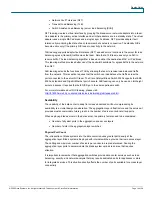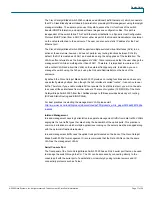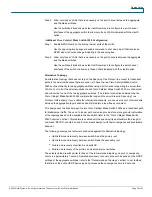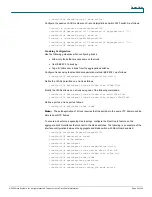
Design Guide
© 2008 Cisco Systems, Inc. All rights reserved. This document is Cisco Public Information.
Page 27 of 28
interface GigabitEthernet0/1
description <<** BladeServer-1 **>>
switchport trunk encapsulation dot1q
switchport trunk allowed vlan 10,60
switchport mode trunk
switchport port-security aging time 20
switchport port-security maximum 1 vlan 10,60
no cdp enable
spanning-tree portfast trunk
spanning-tree bpduguard enable
end
Server Default Gateway Configuration
The default gateway for a server is a Layer 3 device located in the aggregation layer of the data
center. This device can be a firewall, a load balancer, or a router. Using protocols such as HSRP
protects the gateway from being a single point of failure and creates a highly available data center
network. HSRP allows the two aggregate switches to act as a single, virtual router by sharing a
common MAC and IP address between them. Define a SVI on each aggregate switch and use the
HSRP address as the default gateway of the server farm.
Configure aggregation 1 as the active HSRP router. The priority command helps to select this
router as the active router because it has a greater value.
interface Vlan10
description <<** BladeServerFarm – Active **>>
ip address 10.10.10.2 255.255.255.0
no ip redirects
no ip proxy-arp
arp timeout 200
standby 1 ip 10.10.10.1
standby 1 timers 1 3
standby 1 priority 51
standby 1 preempt delay minimum 60
standby 1 authentication <password>
end
Configure aggregation 2 as the standby HSRP router as follows:
interface Vlan10
description <<** BladeServerFarm – Standby **>>
ip address 10.10.10.3 255.255.255.0
no ip redirects
no ip proxy-arp
arp timeout 200
standby 1 ip 10.10.10.1
standby 1 timers 1 3
standby 1 priority 50
standby 1 preempt delay minimum 60
standby 1 authentication <password>
end


































